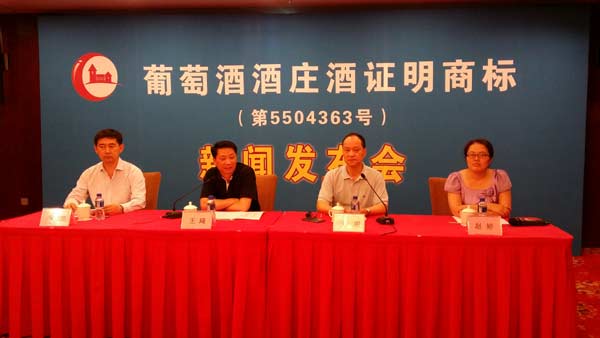 n of June 3, the China Alcoholic Drinks Association held a press conference to introduce "Estate Wine", a certification trademark to identify chateau wines produced in China. The graphic design of the Estate Wine symbol is a combination of the English word "chateau" and the look of a classic chateau castle. However, the association hopes to avoid using the English word "chateau" in the trademark because they think the concept is "too narrow" to define Chinese quality wineries.
n of June 3, the China Alcoholic Drinks Association held a press conference to introduce "Estate Wine", a certification trademark to identify chateau wines produced in China. The graphic design of the Estate Wine symbol is a combination of the English word "chateau" and the look of a classic chateau castle. However, the association hopes to avoid using the English word "chateau" in the trademark because they think the concept is "too narrow" to define Chinese quality wineries.Wang Qi, deputy director and secretary general of the China Alcoholic Drinks Association, said it is the first such trademark the association will introduce. The association applied for the trademark from the State Administration for Industry and Commerce.
A certification trademark attests to quality, but not producer. As the owner of the trademark, the China Alcoholic Drinks Association will also serve as the testing and supervisory body of wineries granted the Estate Wine trademark. Wang Qi said the trademark will be open to all Chinese wineries for application. According to Wang Zuming, secretary general of the China Alcoholic Drinks Association’s wine branch, wines with the trademark will be available at the end of August, or in early September.
"The purpose of the trademark is to set up standards for Chinese chateau and chateau wines, and gradually establish a quality system for chateau wine products," Wang Zuming said. Receiving the certification trademark means a promise of quality and credibility on the part of the applicant, he said.
Wineries applying for the trademark must satisfy some conditions. They need to have vineyards in which they have 100 percent ownership, and the grape growing, winemaking and bottling must all be completed within the winery. They also must be able to put grapes into fermentation tanks on the day they are harvested. The production capacity of each winery should not be lower than 70 metric tons per year.
Wang Zuming said the Estate Wine trademark is not as strict as systems such as Appellation d`Origine Controlee in France, or the DOC and DOCG in Italy.
"Europe has a much longer history of wine-making, which enables detailed classification and verification of origin," he said.
"Also, wine-growing regions are much smaller in Europe than in China. The Estate Wine trademark applies to all wineries in China."
He said as more wineries apply for the trademark, it will be possible for the association to make a more detailed classification and verification of origin system to better guarantee the quality of wine.
The supervisory body of wineries using the trademark will consist of not only wine experts, but also the media and consumers. Consumers can also complain on the association’s official website if they find any problem with wines that carry the trademark.
"In the end, customers will be the beneficiaries, and supervisors of the trademark," Wang Zuming said.





